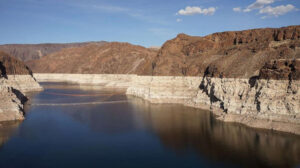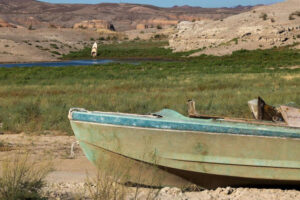APRIL 11, 2023

The Colorado River near Hoover Dam on the Arizona-Nevada border, March 13, 2023. – Xinhua News Agency via Getty Images
Federal officials are proposing a plan to cut water allotments to states dependent on the Colorado River system to combat dwindling water levels on one of the country’s most important bodies of water.
The U.S. Department of Interior’s Bureau of Reclamation released a draft environmental impact statement on Tuesday that details revisions in the operations of Glen Canyon and Hoover Dams, which could potentially evenly cut water allotment for water delivered to California, Arizona and Nevada by as much as one-quarter in order to prevent the Colorado River depleting reservoirs from falling to critically low levels.
It proposed three possible scenarios.
The first of three possible scenarios involves no federal intervention and would rely on the seven states that take water from the Colorado River to come to a deal to prevent deadpool levels that would threaten power production, something they have so far failed to do.
The second option concerns the amount of water released from Glen Canyon Dam, which would be reduced based on water rights. This would mean fewer cuts for California, which has the most senior water rights, and more severe cuts for Arizona and Nevada.
The third scenario would entail water cuts spread evenly by the same percentage across all states, which could prompt legal challenges from states like California with more senior water rights but could avoid worse consequences for states like Arizona and Nevada and tribal communities that could struggle under larger cuts.
The alternatives presented in the draft on Tuesday analyze measures that may be taken to protect system operations in the face of “unprecedented hydrologic conditions” while providing equitable water allocations to Lower Basin communities that rely on the Colorado River System, according to a statement by the Bureau of Reclamation.

Two sunken boats are re-emerged as unprecedented drought reduces Colorado River and Lake Mead to critical water levels, Sept. 20, 2022, in Lake Mead National Recreation Area, Nev. – David Mcnew/Getty Images
The Colorado River Basin supplies drinking water to 40 million people in the U.S., as well as two states in Mexico, fuels hydropower resources in eight states and remains a crucial resource for 30 Tribal Nations as well as agriculture communities across the West, according to the Bureau of Reclamation.
“Failure is not an option,” Interior Department Deputy Secretary Tommy Beaudreau said in a statement. “Recognizing the severity of the worsening drought, the Biden-Harris administration is bringing every tool and every resource to bear through the President’s Investing in America agenda to protect the stability and sustainability of the Colorado River System now and into the future.”
The proposal comes after a decadeslong megadrought has reduced water levels in the Colorado River and Lake Mead and Lake Powell — the two largest reservoirs in the world — to record-low levels.
Water levels in June 2022 at Lake Mead were dangerously low to hitting “dead pool” status, which is below the surface elevation needed to generate power.
The first-ever water shortage was declared for Lake Mead in August 2021, which prompted a reduction in water releases to Arizona, Nevada and Mexico in 2022.
Atmospheric river events have inundated the West with an excess of precipitation — much of which did not cross over the Sierra Nevada mountain range. However, once the snowpack starts to melt, water levels along the Colorado River system will be slightly replenished.
The West cannot rely on one good year of moisture to combat the effects of a drought plaguing the region for nearly two decades, federal officials said.
“Drought conditions in the Colorado River Basin have been two decades in the making,” Bureau of Reclamation Commissioner Camille Calimlim Touton said in a statement. “To meet this moment, we must continue to work together, through a commitment to protecting the river, leading with science and a shared understanding that unprecedented conditions require new solutions.”
Last week, the Biden Administration announced a $15.4 billion investment to enhance the West’s resilience to drought, which will include reducing water demand, maximizing water resources and protecting the communities along the Colorado River Basin.
“The Colorado River Basin provides water for more than 40 million Americans, fuels hydropower resources in eight states, supports agriculture and agricultural communities across the West, and is a crucial resource for 30 Tribal Nations,” the White House said in a press release on Thursday. “Despite recent heavy rain and snow, the historic 23-year drought has led to record low water levels at Lake Powell and Lake Mead.”
Courtesy/Source: ABC News

































































































